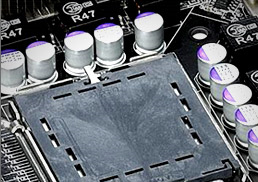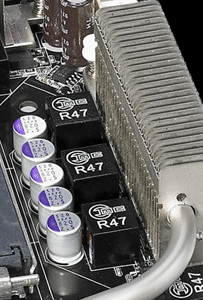Asus P5N32-SLI: Dual x16 - What Dreams Are Made On . . .
by Gary Key on October 27, 2005 12:05 AM EST- Posted in
- Motherboards
This line as spoken by the magician Prospero in William Shakespeare's whimsical play, "The Tempest", reminds us of the uniqueness of the human mind and the fleeting amount of time that we are around to utilize it."We are such stuff, As dreams are made on and our little life
Is rounded with a sleep..."
The Asus P5N32-SLI Deluxe that we will review today is also very unique in several ways and like most computer products in the current marketplace, its life span will be fleeting. However, for those of you who have the opportunity to utilize it, you will find what dreams are made on.
I will say this up front; this is one of the better motherboards that I have had the opportunity to use in the last 20 years. In fact, this board deserves additional testing time in order to explore fully and extract all of its performance potential. In keeping with what we believe is the best option for the current Intel processor lineup, the Pentium D series, we did not test a single core processor on this board. However, based upon the results that we extracted from the 840EE and 820D processors, we will be testing a single core processor on this board in the near future.
While it does not have the quad graphics capability of the Gigabyte GA-8N SLI Quad, the stellar layout of the MSI P4N Diamond, or the extensive feature set of the Gigabyte GA-8I955x Royal that was reviewed recently, this board's capability more than exceeds the sum of its parts. Yes, it does have some quirks as most products will, but Asus has engineered a truly remarkable motherboard utilizing the revised NVIDIA nForce4 Intel Edition SLI for the Northbridge and the NVIDIA nForce4 SLI for the Southbridge resulting in the x16 designation.


 |
 |
One of the main design features that Asus engineered into this board is an exclusive 8-phase voltage regulator power design that can significantly lower operating temperatures while reducing input ripple current and output ripple voltages . In fact, the input ripple current is over three times lower than a traditional 4-phase design while output ripple voltages are four times lower. The power consumption compared to the 4-phase design is about 10% less while the 8-phase design has the advantage of quicker transient responses and increased dependability due to lower thermal values.
What all this means is that your system will run cooler and overclock better compared to other solutions. In fact, through informal testing utilizing the BIOS readings, we found our Intel Pentium 840EE was on average running about 5c cooler in the Asus board compared to other solutions in the same test setup and ambient conditions. We will be conducting more thermal tests with scientific instrumentation in the near future. Our average overclocks were around 5% better than the other boards at more aggressive memory timings and with lower voltages required to the chipsets. While this does not sound like much, the ability of this board to run a CPU that previously topped out in the 3.9GHz range at up to 4.2GHz is impressive. The Asus P5N32-SLI Deluxe was an extremely stable board throughout our testing and did not fail a single time throughout two weeks of varying tests and conditions.
Let's see what this board is capable of now.










70 Comments
View All Comments
Gary Key - Thursday, October 27, 2005 - link
It is an awesome board.Thank you for the comments about the sound tests. We will be expanding this test suite greatly in the coming weeks. If you think BF2 has a hit, wait until you see the F.E.A.R. scores with sound effects at maximum. ;->
However, in order to be consistent we will be testing the latest driver sets for each audio implementation along with adding an X-FI into the mix. The audio drivers within the latest NVIDIA 6.82 platform set are more game friendly than the RealTek versions but you give up some functionality and features for it.
yacoub - Sunday, October 30, 2005 - link
Gary - don't know if you will see this or not, but it would be interesting to see how the X-Fi series Creative card compares to the BlueGears X-Mystique, which is a highly rated ~$90 audio card available from NewEgg among other sites that has an excellent featureset (of course it lacks the latest EAX that Creative keeps for themselves so they have a reason to sell their wares to gamers, but it has more Dolby-related 5.1 features than the X-Fi series).Would be neat to see those two cards compared in "% usage" of CPU during gaming.
Gary Key - Monday, October 31, 2005 - link
Good Day,I have bought several cards the past few weeks including this one and the Chaintech AV-710. I intend to greatly expand the scope of audio testing on the board reviews due to the advances in on-board quality/drivers or the lack of in the nF4 area. I have a hard time understanding why most board manufacturers are shying away from C-Media as their on-board solutions always worked/sounded better than the RealTek AC97 counterparts. In the HD audio area it is a toss up in my opinion but I prefer the SigmaTel codec's on the Intel boards at this time including Intel's software packages. Hopefully I will be able to have the full audio section available in a couple of weeks. The next article series will have a little more information but is not representative of where we will be going in the future.
I appreciate the comments and suggestions. I welcome anyone to email me if you have concerns or suggestions about our information. Obviously we have a format to adhere to and cannot test every possible hardware/software solution but I am always open to suggestions. :-)
yacoub - Thursday, October 27, 2005 - link
Oh and dual true-16x PCI-E slots and the passive cooling are both incredibly desireable features. When the AMD version of the board comes out I'll be all over it provided it reviews as well as this one did.Leper Messiah - Thursday, October 27, 2005 - link
If the AMD version works as well as this one does for intel's, I've got my new mobo picked out. Heat pipe cooling+ 8 phase power= The win! 840EE's at 4.2 might actually give an overclocked X2 a run for its money! :gasp;bob661 - Thursday, October 27, 2005 - link
Except that EE's will run MUCH hotter than X2's. This isn't a big deal if you have your own nuclear reactor.Gary Key - Thursday, October 27, 2005 - link
It was not that bad on this board (a very good description from you), idle temps at 37c, 4.1GHz at 46c according to the bios readings. I believe they were very close as I had a duplicate setup with the MSI P4N in it and you could feel the difference with your hands near the case. We will have thermal tests in the near future.
Karaktu - Thursday, October 27, 2005 - link
One thing I would REALLY like to see added to review articles is the total power consumption of the test setup, both at stock and overclocked settings. There are a couple of power supplies (Coolermaster, Thermaltake) that include attached wattage displays for convenience.This would be useful for a number of reasons, not the least of which would be an idea of how much it's going to cost you to run such a rig. ;)
Joe
Gary Key - Thursday, October 27, 2005 - link
Hi Joe,We have discussed this and it is nice to see a request for it. :-) Hopefully, once I have the test equipment setup then we can include these results in selected articles. You will find this information in the some of the CPU reviews already. We will also start checking thermal readings when a manufacturer introduces new technology onto the board. Asus did this with the eight-phase design and it certainly helped the thermal conditions on the board and with the CPU. This was based on a more subjective review of numbers generated from the bios and monitoring programs (along with overclocking results) which is okay for a high level discussion but is not detailed enough for absolute objective statements.
Thank you.
breetai72 - Monday, October 31, 2005 - link
I find it very hard to believe that this is an 8 phase vreg. Simply counting the inductors indicates that it's only a 5 phase. Can you post the VR controller part number so I can see the datasheet?